
The 3rd Canadian Division is a formation of the Canadian Army responsible for the command and mobilization of all army units in the provinces of Manitoba, Saskatchewan, Alberta and British Columbia, as well as all units extending westwards from the city of Thunder Bay.
Options for Change was a restructuring of the British Armed Forces in summer 1990 after the end of the Cold War.
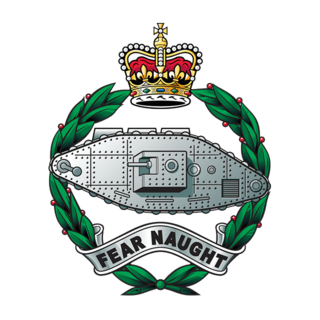
The Royal Tank Regiment (RTR) is the oldest tank unit in the world, being formed by the British Army in 1916 during the First World War. Today, it is the armoured regiment of the British Army's 12th Armoured Infantry Brigade. Formerly known as the Tank Corps and the Royal Tank Corps, it is part of the Royal Armoured Corps.

The Queen's Royal Hussars (The Queen's Own and Royal Irish) (QRH) is a British armoured regiment. It was formed on 1 September 1993 from the amalgamation of the Queen's Own Hussars and the Queen's Royal Irish Hussars. The regiment and its antecedents have been awarded 172 Battle Honours and eight Victoria Crosses. The regiment was based in Sennelager, Germany, until 2019 when it was relocated to Tidworth Camp, England. It is the armoured regiment for 20th Armoured Brigade Combat Team.
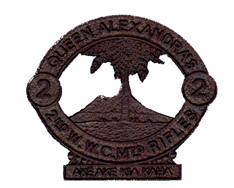
Queen Alexandra's Mounted Rifles (QAMR) is an armoured regiment of the New Zealand Army and forms part of the Royal New Zealand Armoured Corps. The regiment was formed in 1864 and is currently an armoured cavalry unit equipped with NZLAV.

The Royal Australian Armoured Corps (RAAC) is an administrative corps of the Australian Army. It provides the Australian Defence Force's Armour capability, which performs the function of mounted combat. Armour combines firepower, mobility, protection and networked situational awareness to generate shock action and overmatch in close combat. Armour is an essential element of the combined arms approach that is employed by the Australian Army.
The Waikato Mounted Rifles (WMR) is the New Zealand Army's only Territorial Force squadron of the Royal New Zealand Armoured Corps (RNZAC). The Squadron's origins can be traced back to 1869 when the first mounted unit was raised in the Waikato. Today the Squadron is part of Queen Alexandra's Mounted Rifles (QAMR) where it forms the regiment's reserve squadron. WMR's role is mounted reconnaissance and surveillance.
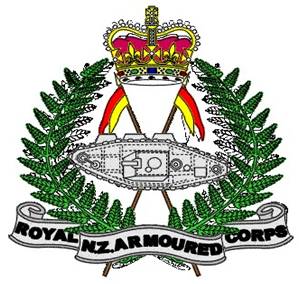
The Royal New Zealand Armoured Corps (RNZAC) is the overall umbrella grouping of Regular Force and Territorial Force units equipped with armoured vehicles in the New Zealand Army. The corps was formed in 1942 as the New Zealand Armoured Corps, before being given the Royal prefix in 1947. The RNZAC is second in seniority of corps within the New Zealand Army.

The Westminster Dragoons (WDs) was a yeomanry regiment of the British Army Army Reserve, located in central London. Its lineage is continued by one of the Royal Yeomanry's six squadrons. Formed in the aftermath of Second Boer War as part of the County of London Yeomanry, the WDs fought in the Battle of Gallipoli and led British forces onto the beaches during the Normandy Invasion in 1944. The squadron most recently saw action on Operation Telic for which it was mobilised for the 2003 war in Iraq.
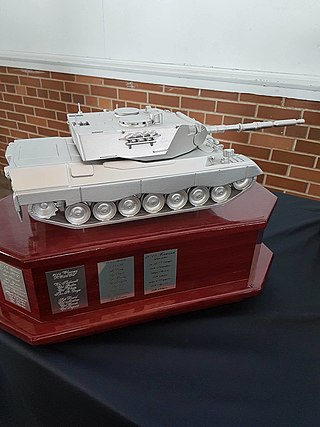
The Worthington Trophy is a Canadian military award. It was awarded annually to the best reserve armoured unit in the Canadian Land Forces. It is named after Major-General F. F. Worthington, known as Fighting Frank – "The Father of the Royal Canadian Armoured Corps".

The 6th Royal Tank Regiment was a regiment of the Royal Tank Regiment, of the British Army, until 1959. It originally saw action as 6th Battalion Tank Corps in 1917.

The Royal Wiltshire Yeomanry (RWY) was a Yeomanry regiment of the Kingdom of Great Britain and the United Kingdom established in 1794. It was disbanded as an independent Territorial Army unit in 1967, a time when the strength of the Territorial Army was greatly reduced. The regiment lives on in B Squadron of the Royal Wessex Yeomanry.
This is the order of battle for the ground forces involved in Operation Crusader, a World War II battle between the British Commonwealth and the European Axis Powers of Germany and Italy in North Africa between 18 November – 30 December 1941.

Armoured reconnaissance is the combination of terrestrial reconnaissance with armoured warfare by soldiers using tanks and wheeled or tracked armoured reconnaissance vehicles. While the mission of reconnaissance is to gather intelligence about the enemy with the use of reconnaissance vehicles, armoured reconnaissance adds the ability to fight for information, and to have an effect on and to shape the enemy through the performance of traditional armoured tasks.

The 1st Armoured Brigade was a formation of the Australian Army during World War II. The brigade was formed in July 1941, at Greta, New South Wales from volunteers for the Second Australian Imperial Force and was assigned to the 1st Armoured Division. Raised initially for service in the Middle East, following Japan's entry into the war, the brigade was assigned to the defence of Australia in case of an invasion. After garrison duties in New South Wales and Western Australia, it was disbanded in November 1944 without seeing active service, although some of its former units saw action later with other formations.

The 3rd/9th Light Horse is a Reserve light cavalry regiment of the Australian Army based in Smithfield, South Australia. It is constituted of a single squadron. It is part of the Royal Australian Armoured Corps (RAAC), the regiment is attached to the 9th Brigade, and currently operates Hawkei Protected Mobility Vehicle - Light (PMV-L). On 26 October 2022, 9th Brigade transitioned as a Direct Command to Forces Command (FORCOMD) as part of an Army wide transformation. 3rd/9th Light Horse, 1st Armoured Regiment officially commenced on 1 November 2022.
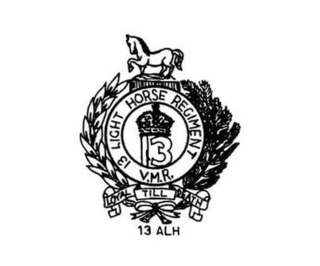
The 13th Light Horse Regiment was a mounted infantry regiment of the Australian Army during the First World War. The regiment was raised in March 1915, and eventually assigned as the mounted regiment for the Australian Corps. During the war the regiment fought against the forces of the Ottoman Empire, at Gallipoli, and against the German Empire on the Western Front. For its role in the war the regiment was awarded twelve battle honours. In 1921, it was later re-raised as a part-time unit of the Citizens Forces, and was briefly amalgamated with the 19th Light Horse. During the Second World War, the regiment was converted into an armoured regiment, designated the "13th Armoured Regiment", although it was disbanded in late 1943 without seeing action.
The 8th/13th Victorian Mounted Rifles was an armoured regiment of the Australian Army Reserve. Formed in 1948, the regiment initially operated M3 Grant medium tanks, but was later re-equipped with Centurion tanks in the late 1950s. Operating out of several depots across northern Victoria and southern New South Wales, throughout the 1950s, 60s and 70s the regiment undertook both an armoured and reconnaissance role operating both tanks and armoured cars before being re-equipped with M113A1 armored personnel carriers in the early 1970s. In 1976, the regiment was reduced to a squadron sized element. It was eventually merged with the 4th/19th Prince of Wales's Light Horse in 1992.

The New Zealand Army use of tanks from after the First World War, through the interwar period, the Second World War, the Cold War and to the present day has been limited, but there is some history. The New Zealand armed forces developed in the early twentieth century but served alongside the British and other Empire and Commonwealth nations in World War I and World War II.














